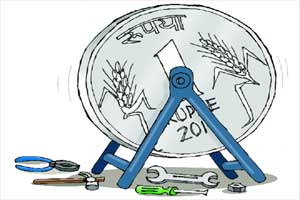India’s budget is meant to provide a yearly roadmap of central government expenditure and revenue projections. Over the years, it has become more than that, a symbolic exercise indicating where economic reforms are headed. I have repeatedly argued that economic reform is a process that cannot be adequately handled within the budget exercise. Economic reform, at this stage, consists of numerous legal and regulatory changes that will improve the functioning of government and of the private sector. However, changes in revenue and expenditure policies do have impacts on the trajectory of the economy, and can work in favour of, or against, economic reform.
Perhaps the most glaring examples of conflict between reforms to promote growth and development on the one hand, and tax and expenditure policies on the other, came during the second UPA government. The massive expansion of welfare schemes, while socially beneficial and politically attractive, created pressures for a set of tax policies (retrospective taxation, high minimum alternative taxes, and others) that generated enormous uncertainty with respect to business investment. Years later, the country is still recovering from these missteps. There have been other recent examples of misguided tax policies, such as taxes on bank withdrawals above a certain size, but they were less pernicious in their effects.
Things had gotten so bad before the change in government that the integrity of the budget was being seriously eroded, with subsidy obligations being rolled over to make the official numbers look like they were meeting fiscal responsibility targets. It may seem like too obvious and basic a requirement, but the top of any budget wish-list has to be a return to rigorous standards of honesty and transparency with respect to revenue and expenditure projections and planning.
The second generic item on my budget wish-list pertains to tax policy in general. There has to be a real focus on low tax rates and broad tax bases. This applies to income taxes as well as to expenditure taxes. The government should not raise exemption limits for personal income taxes, so that more people pay some tax, even if it is at a 5% marginal rate. India’s voters have to make a direct psychological connection between the taxes they pay and the services the government provides to them. The principles of lower rates and broader coverage should apply to the Goods and Services Tax as well, although in the latter case, the complex bargaining with state governments places additional constraints.
The third item on my wish-list pertains to principles of expenditure policy. The new government, in its first budget, already made some symbolic allocations for heroic statues and the like. Having satisfied its political base, there should be a moratorium on new expenditure schemes. It is true that there are urgent needs in multiple areas of public welfare, but these needs will be met through improving government capacity. The replacement of the Planning Commission with the NITI Aayog affords an enormous opportunity for rethinking and reconfiguring central government expenditures, and moving toward a situation where expenditures are decided and incurred at levels of government closer to where they can be evaluated effectively, either state or local. National missions have meant creating parallel bureaucracies at the level of the states, whereas a much smaller expenditure could have been made to lift state government capacity and transparency, achieving similar or better results.
My fourth wish-list item concerns possible exceptions to the overall principle of broad-based taxation. I think the alternative principle that may override that of a broad tax-base is that of dealing with risk. Two primary areas of risk pertain to large infrastructure projects and to start-up companies. In both cases, instituting tax rules that either mitigate downside risk (in the case of infrastructure) or provide stronger incentives for taking on risk, by favourable tax treatment of gains from creating successful new companies, are key areas for reform on the tax side. There is also a possible argument for geographically-based zones of lighter taxation, but it makes more sense to make exceptions based on risk characteristics rather than geography. Indeed, there is a case for better tax administration all round, not just in special economic zones.
A final item involves an exception to my strictures on new kinds of expenditures. If India is to grow annually at 8% or more over the next decade, it will need to invest in digital infrastructure. This is actually much cheaper than building physical infrastructure, and can be a substitute in some cases as well as an important complement in others. If there is one thing the central government should be doing, it is providing the one true national public good for the 21st century—a robust and comprehensive digital infrastructure for all Indians, as individuals or through organisations, to access and use in any way they see fit, whether for education, health, work or entertainment.
The author is professor of economics, University of California, Santa Cruz


